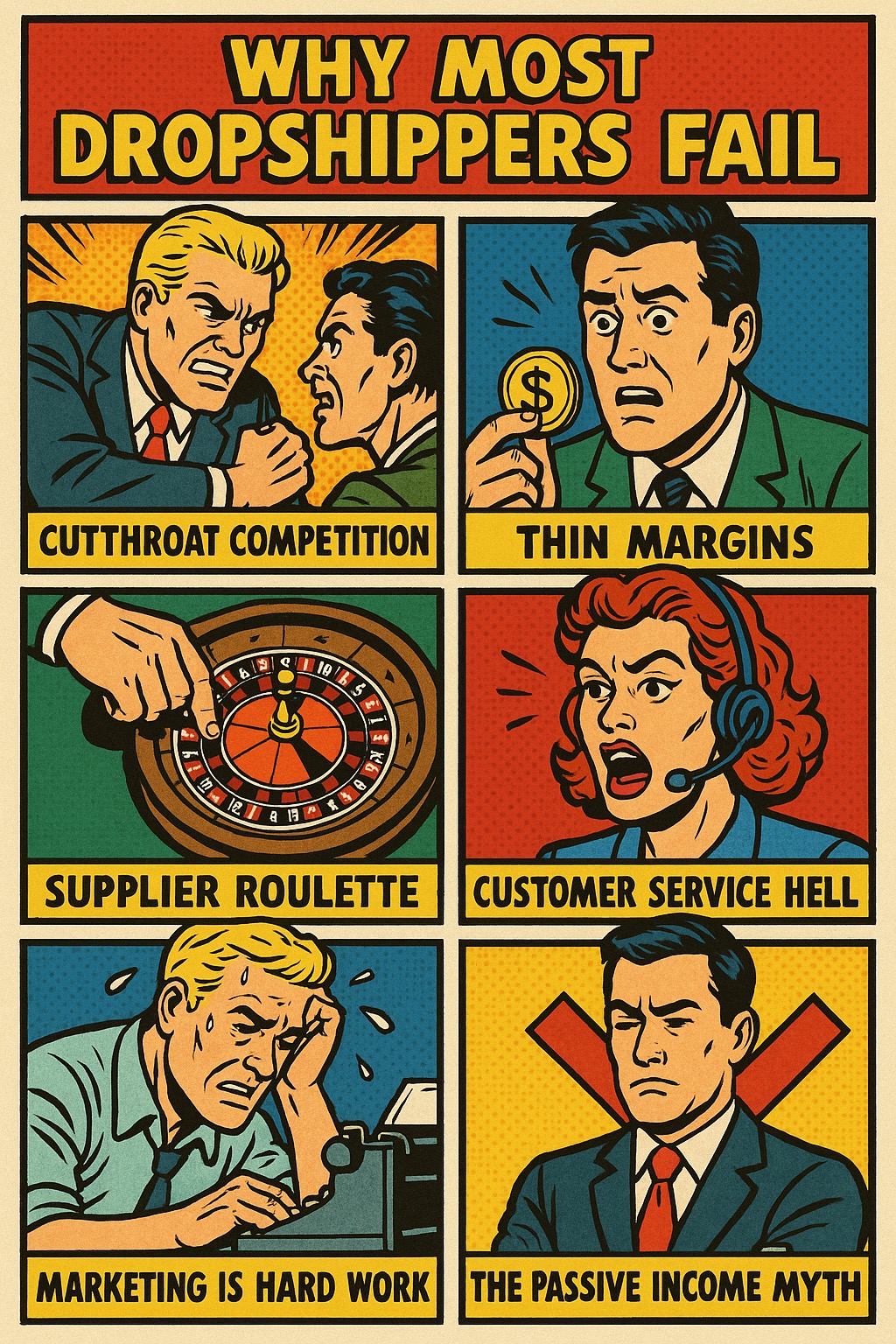Is Dropshipping Worth it in 2025?
Let’s talk dropshipping. Chances are, you’ve seen the hype. Videos flashing fancy cars, gurus promising automated millions, courses guaranteeing overnight success – all by selling products you never even touch. The allure is powerful: start an online store with minimal cash, no inventory headaches, and make money while sipping cocktails on a beach.
It sounds incredible. And the core model – where you market products online, a third-party supplier handles storage and shipping directly to the customer – is legitimately attractive because it lowers the initial financial hurdles of traditional e-commerce.
But here’s where I need to inject a heavy dose of reality, especially as we navigate 2025: Dropshipping is NOT easy money, and it’s certainly not a guaranteed path to passive income right out of the gate.
The landscape has changed dramatically. What might have worked with minimal effort years ago will likely fail spectacularly today. Competition is absolutely brutal. Customers are smarter and demand more. Ad platforms are more expensive and complex.
So, is dropshipping even worth considering anymore?
The short answer: Yes, it can be, but ONLY if you ditch the “get rich quick” fantasy and approach it like the real, demanding business it actually is. The lazy way is dead. The strategic way still offers opportunity.
Ready to leave the job you hate and find the fastest path to online wealth? Learn the best asset you have right now to leverage income and build financial run way in my bestseller "Fire Your Boss." Click here to download the book for free.
Let’s break down the brutal truths, why it can still work if done right, and who should (and shouldn’t) even bother trying.
The Brutal Truth: Why Most Dropshippers Fail Miserably

Before you get starry-eyed, understand the rocks that sink most dropshipping ventures today:
- Cutthroat Competition & Thin Margins: Because anyone can start a dropshipping store with a few clicks, everyone does. This floods the market, especially with generic products sourced from the same handful of overseas suppliers like AliExpress. The result? Fierce price wars, driving profit margins down to razor-thin levels. After ad spend, platform fees, supplier costs, and potential refunds, many find they’re working hard just to break even, or worse.
- Supplier Roulette (Quality & Shipping Nightmares): Your entire business reputation rests on suppliers you likely have little direct control over. Many beginners default to the cheapest options, resulting in:
- Poor Product Quality: Items that look nothing like the pictures or break after one use.
- Excruciatingly Slow Shipping: Customers in 2025 expect fast delivery, thanks to Amazon Prime. Waiting 3-6 weeks for a package from overseas often leads to angry emails, chargebacks, and terrible reviews.
- Inventory Issues: Relying on a supplier’s stock levels means items can go out of stock after you’ve already made a sale, forcing you to cancel orders and damage customer trust.
- Communication Barriers: Dealing with suppliers across different time zones and languages can be challenging when problems arise.
- Customer Service Hell is Your Problem: When that low-quality product arrives broken after a 4-week wait, the customer isn’t emailing some anonymous supplier overseas. They’re emailing you. You are the face of the business. You have to handle the complaints, process the refunds while often eating the cost, and manage the fallout, even though you never touched the inventory. Ignoring customer service will kill your store faster than almost anything else.
- Marketing is Hard Work (and Costs Money): You can have the perfect product and store, but if nobody sees it, you make zero sales. You need to drive targeted traffic. This means:
- Learning Paid Ads: Facebook, TikTok, Google Shopping ads require skill, testing, and budget. It’s easy to burn through cash quickly with ineffective campaigns.
- Or Investing Sweat Equity: Building organic traffic through SEO, content marketing, blogging, or social media takes significant time and consistent effort.
- Simply listing products isn’t enough. You need a real marketing strategy.
- The “Passive Income” Myth: While a mature, well-systemized dropshipping business can become semi-passive, getting there requires immense upfront work. Researching niches, vetting suppliers, building a brand, setting up the store, creating marketing campaigns, handling customer service – it’s incredibly front-loaded with active effort. Expect to work hard, especially in the first 6-12 months.
Ignoring these realities is why the dropshipping graveyard is overflowing.
Why It Can Still Be Worth It (IF You’re Strategic)
Okay, after that dose of reality, why consider it at all? Because if you navigate the challenges strategically, the core benefits still hold appeal:
- Low Initial Capital: You genuinely don’t need to buy inventory upfront. Your main starting costs are platform fees (Shopify, BigCommerce, or WooCommerce), domain name, maybe some sample orders, and your marketing budget. This makes it accessible.
- Wide Product Testing: You can list and test the market viability of various products without buying them first. This flexibility is powerful.
- Location Independence: You can run the business from anywhere with an internet connection.
- Potential for Scalability: If you find winning products and reliable suppliers, and build effective marketing systems, you can scale revenue without directly scaling inventory management headaches.
The key is shifting from being just another reseller of generic goods to becoming a brand builder who uses dropshipping as a fulfillment method.
The Success Factors: How to Make Dropshipping Work in 2025
If you want a fighting chance, you need to focus relentlessly on these areas:
- Niche Down Ruthlessly: Forget “general stores.” Pick a specific niche you understand, ideally one with a passionate audience or one that solves a clear problem. Research thoroughly: Is there demand? Is the audience willing to spend money? Who are the competitors? A tight niche allows for targeted marketing and building a real brand identity.
- Supplier Due Diligence is Non-Negotiable: This is arguably the most critical factor.
- Go Beyond Basic AliExpress: Explore vetted supplier directories such as Spocket, Zendrop, and SaleHoo. Look for specialized suppliers in your niche.
- Prioritize Quality & Shipping Speed: Order samples. Test the products yourself. Understand realistic shipping times before you list items. Consider suppliers with warehouses in your primary market for faster delivery, even if the product cost is slightly higher. Communicate shipping times clearly and honestly to customers.
- Vet Communication: How responsive is the supplier? Can you build a relationship?
- Build a REAL Brand, Not Just a Store: This is how you escape the price race to the bottom.
- Unique Value Proposition: Why should someone buy from your store specifically?
- Professional Storefront: Use a clean design, high-quality unique product photos & videos, and excellent navigation.
- Compelling Copy: Write unique, benefit-focused product descriptions. Don’t just copy the supplier’s terrible English descriptions. Tell a story. Use SEO keywords.
- Consistent Visuals & Voice: Develop a logo, color scheme, and tone of voice that resonates with your niche audience.
- Master Marketing & Traffic Generation: You need eyeballs.
- Choose Your Channels Wisely: Don’t try to be everywhere. Focus on where your target audience hangs out. Is it TikTok? Instagram? Facebook Groups? Pinterest? Google Search?
- Learn Paid Ads or Content/SEO: Either invest money in learning/testing paid ads effectively OR invest significant time in creating valuable organic content and optimizing for SEO to attract organic traffic.
- Track Everything: Monitor your ad spend, conversion rates, and customer acquisition cost relentlessly. Cut losing campaigns quickly, scale winners cautiously.
- Provide Excellent Customer Experience: This builds trust and repeat business.
- Be Responsive: Answer emails and messages quickly and professionally.
- Transparent Policies: Have clear, easy-to-find shipping and return policies.
- Proactive Communication: Inform customers about potential delays before they have to ask.
- Handle Problems Gracefully: Own mistakes even if they’re the supplier’s fault and find fair solutions for your customers.
Who Is Dropshipping Really For in 2025?
It might be worth it IF:
- You are a skilled marketer or willing to dedicate serious time and money to learning.
- You understand the importance of branding and creating a unique customer experience.
- You are meticulous about researching niches, products, and suppliers.
- You are prepared to handle customer service professionally.
- You have realistic expectations about the time, effort, and potential risks involved.
- You see it as a lean startup method for e-commerce, not a magic money machine.
Who Should Definitely AVOID Dropshipping?
- Anyone seeking passive income overnight with minimal effort.
- Anyone who thinks they can just list random AliExpress items and get rich.
- Anyone unwilling to invest time or money in marketing.
- Anyone who dreads dealing with customer complaints or problems.
- Anyone looking for a guaranteed, low-risk venture. It’s lower risk than traditional retail, but not risk-free.
The Bottom Line
So, is dropshipping worth it in 2025? Yes, potentially, but it’s a qualified ‘yes’. It’s worth it if you approach it as a serious entrepreneur building a real brand, focusing intensely on niche selection, supplier quality, customer experience, and effective marketing. It requires significant work, strategic thinking, and perseverance.
If you’re looking for an easy, hands-off way to make money online with no effort, dropshipping will chew you up and spit you out. But if you’re willing to build a real business that leverages the dropshipping fulfillment model smartly, the opportunity still exists. Just go in with your eyes wide open and be prepared to do the work.
Ready to leave the job you hate and find the fastest path to online wealth? Learn the best asset you have right now to leverage income and build financial run way in my bestseller "Fire Your Boss." Click here to download the book for free.









